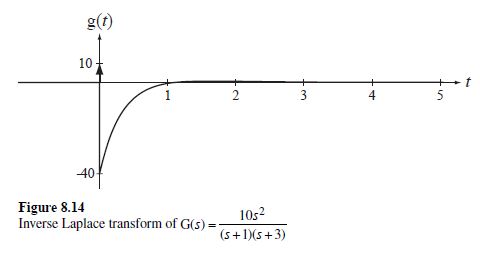Question 8.5: Inverse Laplace transform using partial-fraction expansion F......
Inverse Laplace transform using partial-fraction expansion
Find the inverse Laplace transform of G(s) = \frac{10s²}{(s+1)(s+3)}, σ > 0.
Step-by-Step
The 'Blue Check Mark' means that this solution was answered by an expert.
Learn more on how do we answer questions.
Learn more on how do we answer questions.
This rational function is an improper fraction in s. Synthetically dividing the numerator by the denominator we get
\begin{gathered}s^2+4 s+3 )\overset{\underline{\quad \quad \quad 10}}{10s^2 \quad \quad} \\\quad \quad \quad \quad \quad \quad \quad \quad\frac{10 s^2+40 s+30}{-40 s-30}\end{gathered} \Rightarrow \frac{10 s^2}{(s+1)(s+3)}=10-\frac{40 s+30}{s^2+4 s+3}Therefore
G(s) = 10-\frac{40s+30}{(s+1)(s+3)}, σ > 0.
Expanding the (proper) fraction in s in partial fractions,
G(s)=10-5\left(\frac{9}{s+3}-\frac{1}{s+1}\right), \sigma>0.
Then, using
e^{-a t} \mathrm{u}(t) \stackrel{\mathcal{L}}{\longleftrightarrow} \frac{1}{s+a} \quad \text { and } \quad \delta(t) \stackrel{\mathcal{L}}{\longleftrightarrow} 1we get
g(t) = 10δ(t) − 5(9e^{−3t} − e^{−t} )u(t)(Figure 8.14).

Related Answered Questions
Question: 8.13
Verified Answer:
First, Laplace transform both sides of the equatio...
Question: 8.14
Verified Answer:
We can write nodal equations.
C_{1}\frac{d}...
Question: 8.15
Verified Answer:
This can be factored into
\mathrm{H}(s)={\f...
Question: 8.12
Verified Answer:
Derive the same pair from \operatorname{u}(...
Question: 8.11
Verified Answer:
Using −t g(t)\stackrel{\mathcal{L}}{\longle...
Question: 8.1
Verified Answer:
The Laplace transform of this sum is the sum of th...
Question: 8.10
Verified Answer:
We have already found the Laplace transform of u(t...
Question: 8.9
Verified Answer:
Using the s-domain shifting property
e^{-(5...
Question: 8.8
Verified Answer:
\begin{aligned}(a) \mathrm{h}(t)=5 e^{-4 t...